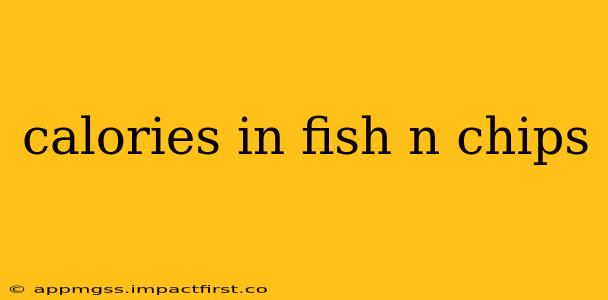Fish and chips, a beloved British takeaway, is undeniably delicious. But how many calories are we really consuming when we indulge in this classic? The answer, unfortunately, isn't a simple number. The calorie count varies wildly depending on several factors, making it crucial to understand what influences the final tally. This comprehensive guide will delve into the calorie content of fish and chips, exploring the contributing factors and offering tips for making healthier choices.
What Factors Influence the Calorie Count of Fish and Chips?
Several elements significantly impact the overall calorie count of your fish and chips. Understanding these factors is key to making informed decisions about your portion size and preparation method.
Type of Fish:
Different types of fish have varying calorie and fat contents. For example, cod tends to be lower in fat than haddock, resulting in fewer calories per serving. The size of the fish portion also significantly impacts the total calorie count.
Batter Type and Quantity:
The batter is a major calorie contributor. A thick, heavily breaded fish will have substantially more calories than one with a lighter, thinner batter. The type of batter also matters; some batters are richer and contain more fat than others.
Cooking Method:
Deep-frying is the traditional method, and it adds significant calories due to the oil absorption. While baking or air-frying are healthier alternatives, they might slightly alter the taste and texture of the fish.
Portion Size:
The size of both the fish and chips dramatically affects the calorie count. Larger portions naturally mean more calories. Consider opting for a smaller portion or sharing with a friend to manage your calorie intake.
Type of Oil Used:
The type of oil used for frying significantly impacts the final calorie and fat content. Healthier oils, such as those with a high smoke point, might be a better option, but they can still contribute significantly to the overall calorie count.
Chips (Fries) Preparation:
The type of potato used, the cutting style, and the frying method all influence the chips' calorie content. Thick-cut chips generally contain more calories than thin-cut chips. Again, oil absorption during frying significantly adds to the calorie count.
How Many Calories Are in a Typical Serving of Fish and Chips?
A typical serving of fish and chips (one medium-sized fish and a regular portion of chips) can range from 700 to 1200 calories or even more, depending on the factors mentioned above. This substantial calorie count highlights the importance of mindful consumption and portion control.
How Can I Reduce the Calorie Count of My Fish and Chips?
While indulging in fish and chips occasionally is fine, several strategies can help reduce the calorie intake.
Choose Baked or Air-Fried Options:
Opting for baked or air-fried fish and chips significantly reduces the calorie content by eliminating the oil absorption from deep frying.
Select Leaner Fish:
Cod is generally a leaner option compared to other types of fish, leading to fewer calories.
Request a Lighter Batter:
Ask for a thinner batter or even choose to have the fish grilled or baked without batter.
Control Portion Sizes:
Order a smaller portion of fish and chips, or share a larger portion with someone else.
Add Healthy Sides:
Complement your fish and chips with healthier side options like a side salad instead of extra chips.
What Are the Nutritional Benefits of Fish and Chips? (If any?)
While high in calories, fish and chips can offer some nutritional benefits depending on the ingredients. Fish is a good source of protein and omega-3 fatty acids, essential for heart health. However, these benefits are often overshadowed by the high fat and calorie content from frying and the potentially high carbohydrate content from the chips.
Are There Healthier Alternatives to Traditional Fish and Chips?
Yes! Several healthier alternatives exist, such as baked or grilled fish with a side of steamed vegetables or a small portion of sweet potato fries. These options offer a similar level of satisfaction with a significantly lower calorie and fat content.
This detailed analysis should provide a clearer understanding of the calorie content in fish and chips and how to make healthier choices when enjoying this beloved dish. Remember, moderation and informed decision-making are key to a balanced diet.
